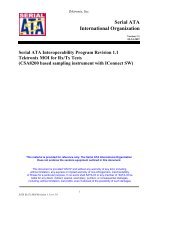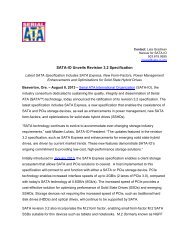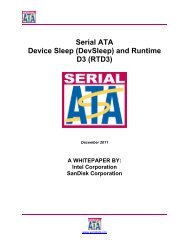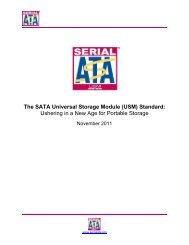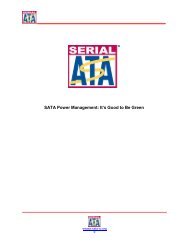1.0 - SATA-IO
1.0 - SATA-IO
1.0 - SATA-IO
- No tags were found...
Create successful ePaper yourself
Turn your PDF publications into a flip-book with our unique Google optimized e-Paper software.
©LeCroy CorporationTest TSG-03 – Differential SkewPurpose: To verify that the Differential Skew of the PUT’s transmitter is within the conformance limits.References:[1] <strong>SATA</strong> Standard, 7.2.1, Table 31– Transmitted Signal Requirements[2] Ibid, 7.2.2.2.10 – TX Differential Skew[3] Ibid, 7.4.15 – Intra-pair Skew[4] <strong>SATA</strong> PRE-TEST MOI[5] <strong>SATA</strong> Interoperability Program Unified Test Document, 2.15.3Resource Requirements:Same as for TSG-01.See appendix A for details.Last Modification: March 25, 2009Discussion:Reference [1] specifies the Transmitted Signal conformance limits for <strong>SATA</strong> products. This specificationincludes conformance limits for Differential Skew. Reference [2] provides the definition of this term for thepurposes of <strong>SATA</strong> testing. Reference [3] defines the measurement requirements for this test. Reference [4] describesthe procedure for placing the PUT into BIST mode to generate the required test patterns.This test is performed by measuring the mean skew of TX+ rise to TX- fall and TX+ fall to TX- rise at the50% levels of the single-ended waveforms. The 50% level is computed with respect to the waveform’s amplitude asdetermined from the statistical distribution of data point values in the waveform. By using the 50% level themeasurement works even in the presence of a DC offset. The measurement is made on a 14µs portion of theacquired waveforms described in TSG-01. This amounts to 21,000 UIs at 1.5Gb/s, 42,000 UIs at 3.0Gb/s or 84,000UIs at 6.0Gb/s.The cables connecting the <strong>SATA</strong> test fixture to the oscilloscope must be deskewed before the data iscollected. Uncompensated cable skew contributes directly to measured differential skew.This test is only run once at the maximum interface rate of the product (1.5Gb/s, 3.0Gb/s or 6.0Gb/s).Test Setup:Same as for TSG-01.Test Procedure:The channels should be deskewed before performing this test. See Appendix A for details. The testprocedure then proceeds as follows:6) Open the QualiPHY <strong>SATA</strong> PHY, TSG, OOB test suite. See Appendix B for details.7) Select an appropriate configuration for the maximum supported speed with TSG-03 selected.8) Run the test.9) When prompted to produce a required test pattern set the product to generate that pattern. SeeAppendix C for details. Check the pattern on the oscilloscope to make sure it is correct. Press“OK” to continue.10) When the test completes, generate a report. Observe the results for TSG-03 in the report.Differential Skew is reported for HFTP and separately for MFTP. TSG-03 passes only if bothresults, Differential Skew for HFTP and for MFTP, pass.Observable Results:The TX Differential Skew shall be at most 20ps for products running at either 1.5Gb/s, 3.0Gb/s or 6.0Gb/s.LeCroy Corporation 24 <strong>SATA</strong> PHY, TSG, OOB LeCroy MOI rev 1.4 version <strong>1.0</strong>



